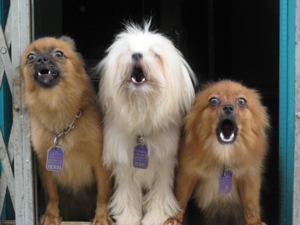
Source: #300 - Parallel lines, Dee West, Flickr
In the introduction to this lesson, you learned that parallelism is defined as the repetition of words, phrases, clauses, and sentences that have the same grammatical structure and that its purpose is balance, indicating that two (or more) ideas have the same weight or importance. In this section of the lesson, we will concentrate on words. For a list of actions (verbs) or items (nouns), you must maintain parallel structure.
Nonparallel List
My dog barks, jumps, and is wagging his tail when the doorbell rings.
Parallel List
My dog barks, jumps, and wags his tail when the doorbell rings.

Source: barking dogs, PradaDearest, Flickr
The verbs in the first sentence vary in form; the first two (barks and jumps) are present tense, while the third verb (is wagging) is a progressive verb phrase. The verbs in the second sentence are parallel or balanced in form, and they are all present tense. Let’s look at another example.
Nonparallel List
My dog loves kibble, doggie biscuits, and chewing on bones.
Parallel List
My dog loves kibble, doggie biscuits, and bones.
The first sentence mixes nouns (Kibbles, doggie biscuits) with a gerund (chewing). The second sentence achieves parallel structure by making every item in the list a noun.
Making verbs parallel can be tricky. It is important to keep them in the same form. For example, you shouldn’t mix gerunds (which end in -ing) and infinitives (which begin with the word to). Listen to the parallel structure rap created by students in a communications class. The rappers draw your attention to the balance created by parallel verbs.
Source: Parallel Structure (The Rap), Danielle Salazar, YouTube
In the exercise that follows, identify the phrase that will complete the series in a parallel fashion. After clicking a or b to respond, carefully read the explanation that appears.

1. Tom’s schedule included algebra, English, and __________________.
2. High school freshmen are encouraged to earn good grades, to become involved in extracurricular activities, and __________________.
3. High school freshmen are encouraged to earn good grades, to participate in extracurricular activities, and __________________.

Source: old town, micmol, Flickr

Source: patterns, jima, Flickr
The chart below contains some examples of words arranged in parallel patterns. The parallel words appear in red.
| Pattern | Example |
|---|---|
| Noun + Noun | McDonald’s breakfast menu includes biscuits and bagels. |
| Verb + Verb | I ordered a biscuit and tasted my friend’s bagel. |
| Adjective + Adjective | The meal was cheap and filling. |
| Adjective-Noun + Adjective-Noun | My breakfast consisted of a tasty biscuit and a piping-hot coffee. |
| Adverb + Adverb | I ate hurriedly and happily. |
| Gerund + Gerund | Eating and drinking at McDonald’s is part of my weekday morning routine. |
| Gerund + Gerund | Eating biscuits and drinking coffee at McDonald’s is part of my weekday morning routine. |
| Infinitive + Infinitive | To eat and drink at McDonald’s in the morning is a special treat.(Hint: We understand that the to before eat also carries over to drink.) |
| Infinitive + Infinitive | To eat an Egg McMuffin and to drink a latte at McDonald’s in the morning is a special treat. (Hint: You may repeat “to” if you wish.) |
Refer to the chart above as you complete the next exercise. From each set of sentences, click on the one that demonstrates proper parallel structure. Follow the pattern that appears before each sentence.

Parallel structure helps you express similar or related ideas clearly and smoothly. It lends balance and rhythm to your sentences and makes them pleasing to the ear. (Notice the parallel verbs in the preceding sentence: lends and makes.)